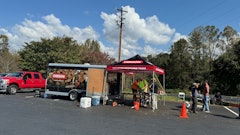
Picture a thriving tree: Its thick bark runs the entire length of the trunk, protecting the nutrients that lie within. The lush emerald green leaves reach toward the sky, proof of all the hard work it has put in to achieve growth, even in the dormant winter months. Yes, it may have weathered a few storms and bear the scars. It may even have a few desiccated parts that may need to be trimmed back, but, its network of roots runs deep underground, anchoring it firmly to the soil.
It's stable, it's steady, it's solid. Those words reflect how landscape professionals view the current state of the green industry.
Over the course of several months, Green Industry Pros spoke to manufacturers, landscape professionals and industry experts about the current state of the green industry. Overall, 424 individuals interacted with Green Industry Pros’ State of the Industry survey, giving a comprehensive overview of how the landscape industry looks.
According to the survey, 21% of respondents said the state of the industry was excellent, 56% said good, 21% said fair and 2% said poor.
Through that report and subsequent interviews, landscape professionals, manufacturers and industry experts dig into where the industry is firmly rooted, the challenges it has weathered, what items may need to be trimmed and potential opportunities for branching out.
2024 in review
pros agree that the landscape industry has reached a more controlled midpoint.
“The 2020s have seen some record sales years for the landscape industry, especially during COVID when homeowners literally watched their grass grow, and they had time on their hands to focus on improving their yards,” says Carissa Gingras, director of marketing, North America | Forestry, Lawn & Garden, Oregon Tool. “2020 was all about managing allocations and inventory. 2021 and 2022 were all about dealers loading up on the products they couldn’t get in 2020. 2022 and 2023 were abnormal weather years. There doesn’t seem to be a normal anymore.”
Additionally, over the past few years, there have been significant pricing swings with commodities, but providers are finally seeing stabilization, says Brian Rowan, vice president, category management for SiteOne Landscape Supply.
Gringas adds that it’s been realized that the “new normal” is not a static state, so it becomes all about adaptation and change.
Jon Matson, vice president of sales and marketing for Briggs & Stratton, says manufacturers are working to understand the true demand following a COVID correction.
“We’re finally coming out of all of the challenges that COVID threw at us,” Matson says. “As homeowners are now starting to get really busy again and increasingly returning to the office, landscapers are benefitting as their clients have less time and more need for their services. We're still facing some inflationary pressures, which affect retail financing. My gut says that the new normal is potentially a more fluid and more agile position on inventory as we move on.”
Matson notes that as the season progressed through 2024, dealers wanted to see inventory taken down to a manageable level. Now, dealers are starting to stock back at normal levels for 2025. Manufacturers, too, have returned to more normal levels as supply chain challenges have evened out, and most manufacturers have started to weather the economic forces.
Overall, the industry may sway in the wind to accommodate the tougher gales brought on by inflation and labor shortages, and it may need to adapt to a "new normal," but overall, the industry remains relatively steady.
Storms to weather
Here's a look at the headwinds landscape professionals face.
1. Economic forces
While inflation has cooled over the last several months, the challenge still lurks in landscapers’ minds. In fact, 36% of survey respondents listed inflation and price increases as their primary concerns.
Kirk Brown, owner of Outdoor Splendor, formerly Kirk’s Lawn Care in Douglassville, Pa., says some consumers were more cost-conscious due to the state of the economy.
“We noticed some slowing in client spending for large landscape and hardscape projects,” Brown says. “We were able to keep our install crews busy, but we did not have the backlog of projects we have had in past years. Hiring qualified team members continues to be a challenge.”
Over the years, Pierre Bridger, director of operations for Vibrant Outdoors in Indianapolis, Ind., says that it’s been harder for companies to make money on items such as mowing due to price gouging among competition.
“That’s the industry’s fault because we’ve taught (landscapers) to beat the heck out of each other on price, and so (customers) can get away with not paying a fair fee,” Bridger says. “As the industry has aged, we’re getting better at holding the line on price, but the newer companies don’t seem to know that yet.”
These economic concerns have led some to repair equipment, rather than replace it.
“Contractors are still focused on inflation and its impact on business,” Gringas says. “They need to hang on to their money. In these environments, parts businesses like ours are doing well because users are repairing, not replacing as much.”
However, many pros still bought new equipment for the purposes of labor savings, efficiency enhancements and government incentives. Of the respondents surveyed, 73% said they bought new equipment in 2024, but 27% said they did not. Reasons included:
- “The purchase of certain energy-saving equipment or new energy vehicle manufacturing equipment can enjoy high tax deductions and financial subsidies.”
- “In order to promote the development of green industries, the government has introduced a series of incentive policies and subsidy measures.”
- “Technology integration for easy production to meet customers demand.”
- “We bought new equipment in 2024 because our existing machinery was outdated and frequently breaking down, which was causing delays in our projects. The new equipment has improved efficiency and reliability, allowing us to serve our clients better.”
2. Labor depletion
Of the survey respondents, 29% said that labor is their most pressing concern.
Mark Schneid, head of commercial operations, North America, Envu, notes that it’s not just about hiring good people, but it’s also about giving them fair pay and providing them the opportunity to grow within a company.
“We talk about the customer experience, but let’s talk about the employee experience,” Schneid says. “Let’s equip them with the right tools to do the job as efficiently as possible as well as the right chemical solutions that’ll get them the best results, so customers are saying ‘wow, thank you,’ instead of pointing out a break in weed control.”
Gary Garvin, president of J&G Landscaping in Casper, Wyo., says labor has been the company’s biggest hurdle for the last 15 years.
“Nobody wants to do labor anymore, even though we have nice equipment—you cannot find people that want to run it,” Garvin says.
Scott Horoszewski, owner of Acme NLS in Swanton, Ohio, agrees.
“It’s getting to where more people don’t want to do this type of work—they want to sit at home and watch YouTubers and influencers who say they can make money doing that,” Horoszewski says. “They don’t want to be out there in the sun.”
To combat that challenge, Acme is hiring people in at a higher rate and offering more benefits such as 401K and retirement plans.
Matson adds that the seasonality of the work may prove to be a big reason why keeping still labor is difficult for companies.
“Dealerships are trying to find technicians, and landscapers are trying to find people who will work from sunup to sundown, and it’s seasonal work, which is why snow is important,” Matson says. “If you can keep the totality of your workforce intact for the entire year, that provides more continuity for that business in the long term.”
3. Legislative focus
Both legislation and end customer preference are driving new product usage trends, Rowan says.
“The impact has been most noticeable with pesticide (i.e., imidacloprid), fertilizer (phosphorous) and outdoor power equipment (petrol emissions),” Rowan says.
Thirteen percent of respondents say regulatory issues have become a primary concern.
When asked how to stay ahead of these challenges, one survey respondent said, “Staying involved in state and national associations to have a voice in the regulatory environment.”
Bridger agrees.
“We still have markets where there are groups of folks that would like to eliminate certain pesticides and have control over what we do as an industry—and that’s concerning,” Bridger says.
He reflects on an instance in Indiana where if Senate Bill 216 had passed as written, it would have eliminated licensure for for-hire lawn care applications.
“As it turned out, we were able to amend the bill, but there were a lot of stakeholders who joined hands to make that happen,” Bridger says. “I’m concerned there are states that may not be as organized as we were, and when that happens in one state, it’s going to keep moving.”
Trends
Landscape professionals discuss what’s currently trending in the green industry.
1. Efficiency enhancements
With labor still a primary concern within the industry, it’s no wonder landscape companies are looking for products to alleviate that.
For example, Garvin says if there’s a piece of equipment that can save on labor, his company buys it.
“We have mini excavators that take the place of a shovel, ride-on machines—it seems we own it all because we can’t find any laborers,” Garvin says.
Matson says companies also seek out products that require less maintenance and less downtime.
“In the past, a landscaper may have had the ability to flex employees who would have been able to do maintenance in the shop at the end of the week or over the weekend,” Matson says. “Now it's all hands on deck to just perform for the clients that they have on the books.”
Gringas adds that technological advances that help landscapers reduce downtime, manage windshield time, track profitability and repair equipment just in time will lead to foundational shifts in the way landscape companies work.
“It’s not just about AI helping landscape companies write job descriptions for new hires or about the back-end accounting programs that help companies track their expenses,” Gringas says. “It’s about the technology that makes a landscape company more efficient and profitable with current resources, especially when labor continues to be a challenge.”
Peter Bigwood, general manager, Mecalac North America, says there’s also been a growing demand for machines that are productive and versatile.
“In the case of labor, we find more landscaping contractors are adopting versatile equipment that can excel in several applications to improve productivity and reduce the number of required workers on any given job,” Bigwood says.
Lee Smith, director of product strategy at Bobcat Co., adds that landscape customers are finding that attachments can improve their operations.
“By pairing the right attachments with their equipment, companies can significantly boost jobsite productivity, allowing operators to perform a wider range of tasks with a single machine,” Smith says. “This versatility translates to increased efficiency and reduced operating costs. Additionally, different attachments also help equipment owners extend their operations from season to season. We see many customers using their loaders or tractors for landscaping in the warmer seasons, then leveraging snow management attachments in the winter to extend their working season.”
New technology has also played a role in transforming the way landscape companies do business.
Over the last several years, Outdoor Splendor has integrated technology to text message with clients instead of emailing and redesigned its software to allow clients to view, customize and sign up for plans online.
“A lot of our clients prefer texting, and with us having that capability, they love it,” Brown says. “(With the software), they can see their pricing change in real time based upon the selections they make and complete and sign the agreement all online. This has allowed us to upsell more and keep things organized.”
2. Electrification versus gas
The debate between gas-powered and battery-powered equipment has remained hot over the past several years, but some professionals are saying that electrified equipment may not take hold as quickly as previously expected.
One major benefit of electric equipment comes with the sustainability aspect of fewer emissions.
According to the survey, 15% of respondents said sustainability is essential to them, 16% said it's very important, 38% said it's important and 24% said it's somewhat important, with only 7% saying it is not important at all.
“As far as electrification, I think that there is a time and a place for electrification, but we're also seeing it as a challenge because of the increased cost of an electrified product,” Matson says. “So, we're seeing a little bit of a spike in gas-powered equipment that lets us know that gas is here for a long time to come.”
Smith says he expects to see more alternative-power machines on the market.
“Demand for electric equipment will likely continue to grow as landscapers learn more about the technology, its benefits and how it can open the door to a new customer base,” Smith says.
Brant Kukuk, compact equipment manager at Ditch Witch, has noted the shift to electric extends beyond smaller tools to include ground-engaging equipment as well.
“Electric equipment offers numerous benefits including increased efficiency, significant time savings and enhanced power,” Kukuk says. “As the industry embraces electrification, it’s crucial for contractors to stay ahead of the curve. By considering electric equipment now, contractors can position themselves for success in the future.”
3. Autonomous equipment
Also addressing the labor issue, autonomous equipment has rolled up to the landscape scene.
Gringas notes that landscape professionals should not be wary of this technology as it can provide them with the time to pursue other higher-profit work.
“Autonomous mowers aren’t replacing the humans—they are taking care of the low-profitability chores, freeing up the crew for higher-value offerings like design-build,” Gringas says. “Technology is a tool, not a substitute.”
Bridger adds that by incorporating autonomous equipment into a fleet, landscape companies may open up their recruiting pool.
“We could recruit someone who is not a traditional landscaper and hire someone that understands the technology,” Bridger says.
4. Private equity firms
Consolidation has continued within the industry as private equity firms (PE) have become more active.
“The PE firms are grabbing a lot of these smaller landscape companies, which the firms are then aggregating for scale, and I think there's more to come as dealers are aging and as we deal with this shortage of people wanting to get into the dealership space,” Matson says. “It's creating an opportunity for PE firms or even larger dealers to consume smaller dealers and scale for efficiency.”
In response to private equity firms carving space for themselves in the landscape industry, one survey respondent said, "Continued consolidation of privately owned companies is opening the door for less competition in the marketplace by locally based, privately owned companies and putting us in a favorable position to only compete with the national chains or equity-firm owned companies that cannot deliver personalized service."
Another agreed that the consolidation offers an opportunity for smaller companies: "Consolidation of local landscape contractors by national companies allows for us to uniquely offer personalized service in our region. Most competitors our size have sold out to national chains."
5. Value-add opportunities
Many companies have branched out to look for higher-revenue opportunities.
“They may have started just cutting grass, and now they’re pursuing landscape installs or offering sprayer-spreader services on the fertilizer application side of the business where the margins are really good,” Matson says. “Those opportunities take the right skilled labor, education and certification.”
Kukuk says branching into other segments can help ensure a more stable and diversified business, especially when seasonal work, like snow removal, is unreliable.
“This strategy allows them to tap into new revenue streams and sustain their business while waiting for an uptick in work in specific industry segments,” Kukuk says. “There has been a notable increase in demand for bigger stand-on skid-steers, which provide contractors with the power and versatility needed to excel in tree care and hardscaping projects. We have also noticed that rental yards are more cautious with new purchases unless utilization rates justify them. Smaller landscaping tasks that require walk-behind trenchers or smaller stand-on skid-steers have been impacted by inflation and reduced disposable income, leading to a decrease in demand for these machines.”
Other “outside the box” options, such as holiday lighting, are options to expand as well.
“Our holiday lighting services really overperformed versus 2023,” Brown says. “Demand is up for seasonal decorating services.”
However, Brown notes that with the demand of holiday lighting rising, there has been a flood of installers that have entered the market that don't charge enough for their services and as a result, don't take care of the clients, echoing Bridger's sentiment on pricing.
“That could be selling them homeowner grade instead of commercial grade lights or never coming back to take the lights down after the holidays,” Brown says. “We have had to educate people on the value of choosing us and our services. We offer a 100% lifelong warranty on our lights, and our all-inclusive pricing includes service calls within 48 hours of notification. We do what it takes to make our clients satisfied, full stop.”
6. Outdoor functional spaces
A trend that began with COVID, customers are still asking landscape contractors to boost their outdoor spaces.
Landscape functionality is becoming more important to homeowners, meaning they can utilize their outdoor space for a longer duration of the year, and it be flexible for a variety of activities, Brown says.
“Specifically with patios, it's making sure there is ample seating for get-togethers, heaters or fire features for the colder months, landscape and patio lighting for summer nights, outdoor kitchens and more,” Brown says. “It's not that functionality wasn't important before but with the 2024 economy, it was more top of mind to homeowners that they get the most functionality for their money.”
On the horizon
One trend to expect over the next year or so includes continued adoption of products that address labor concerns, such as slow-release fertilizers, robotic mowers, products with minimal maintenance and products that deliver greater efficacy.
Darren Gruner, founder of Turf's Up Radio and principal of TotalScape Design in Coral Springs, Fla., adds that sustainability and regulatory changes will also continue to affect the industry.
"As we look toward the future, challenges such as water scarcity, labor shortages and regulatory changes are expected to shape the landscape industry," Gruner says. "Innovation, collaboration and a commitment to sustainable practices will be key drivers for success in navigating these complex challenges and embracing opportunities for growth."
Schneid notes that continued innovation and education will also come to the forefront.
“It’s how can we as a partner bring new solutions, ideas, training and education that can help lawn care and landscape professionals be more proficient in what they’re doing," Schneid says. "We’re focused on all of those things to deliver great solutions and innovation and also be great stewards, in conjunction with our lawn and landscape professionals, to get those best results each and every time.”
Matson says he expects landscape companies to start purchasing new equipment in the next year, especially if it snows in areas where winters have been mild the past several years.
“We haven't had very good snow in the last two to three years, and that's a big revenue generator for landscapers, especially in the Midwest and the Northeast. That gives landscapers that seed money to purchase equipment early in a new year,” Matson says. “So, I'm expecting really good snow this year, and I'm expecting landscapers to be in the market to replenish and repurchase products that might have gotten a little bit long in the tooth.”
While much of the market has leveled out, Gringas says the industry is still experiencing certain dynamics that haven’t previously occurred.
“Back-to-back hurricanes in the Southeast causing unimaginable damage and a first-ever president who was reelected after losing the previous election are market dynamics that we’ve never seen before,” Gringas says. “Obviously, we’re keeping an eye on the incoming administration and preparing for various scenarios related to different potential policy proposals that may impact the industry as a whole from landscapers to dealers, distributors and ultimately manufacturers.”
Bigwood says the end of 2024 makes him cautiously optimistic for 2025.
“Interest rates are starting to ease, demand is rising and the supply chain bulges are working themselves out,” Bigwood says. “Hopefully, that remains, and the landscaping industry experiences a strong, prosperous year.”
Landscape pros agree: 27% are very optimistic about the year to come, 42% are somewhat optimistic, 24% are neutral, 6% are somewhat pessimistic and 1% are very pessimistic. In all, many landscape pros think the industry will flourish, spreading both branches and roots, in 2025.
Are you interested in hearing advice from landscape professionals in the industry? Take a look at what they recommend to new-comers and seasoned industry veterans alike.


























